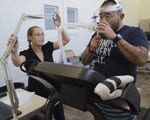Pawpawsaurus’s hearing wasn’t keen, and it lacked the infamous tail club of Ankylosaurus. But first-ever CT scans of Pawpawsaurus’s skull indicate the dino’s saving grace from predators may have been an acute sense of smell.
Well-known armored dinosaur Ankylosaurus is famous for a hard knobby layer of bone across its back and a football-sized club on its tail for wielding against meat-eating enemies.
It’s prehistoric cousin, Pawpawsaurus campbelli, was not so lucky. Pawpawsaurus was an earlier version of armored dinosaurs but not as well equipped to fight off meat-eaters, according to a new study, said vertebrate paleontologist Louis Jacobs, Southern Methodist University, Dallas. Jacobs is co-author of a new analysis of Pawpawsaurus based on the first CT scans ever taken of the dinosaur’s skull.
A Texas native, Pawpawsaurus lived 100 million years ago during the Cretaceous Period, making its home along the shores of an inland sea that split North America from Texas northward to the Arctic Sea.
Like Ankylosaurus, Pawpawsaurus had armored plate across its back and on its eyelids. But unlike Ankylosaurus, Pawpawsaurus didn’t have the signature club tail that was capable of knocking the knees out from under a large predator.
Ankylosaurus lived about 35 million years after Pawpawsaurus, around 66 million years ago toward the end of the Cretaceous. During the course of its evolution, ankylosaurids developed the club tail, and bone structure in its skull that improved its sense of smell and allowed it to hear a broader range of sounds. “Stable gaze” also emerged, which helped Ankylosaurus balance while wielding its clubbed tail.
“CT imaging has allowed us to delve into the intricacies of the brains of extinct animals, especially dinosaurs, to unlock secrets of their ways of life,” said Jacobs, a professor in the SMU Roy M. Huffington Department of Earth Sciences.
While Pawpawsaurus’s sense of smell was inferior to Ankylosaurus, it was still sharper than some primitive dinosaur predators such as Ceratosaurus, said vertebrate paleontologist Ariana Paulina-Carabajal, first author on the study.
“Pawpawsaurus in particular, and the group it belonged to — Nodosauridae — had no flocculus, a structure of the brain involved with motor skills, no club tail, and a reduced nasal cavity and portion of the inner ear when compared with the other family of ankylosaurs,” said Paulina-Carabajal, researcher for the Biodiversity and Environment Research Institute (CONICET-INIBIOMA), San Carlos de Bariloche, Argentina. “But its sense of smell was very important, as it probably relied on that to look for food, find mates and avoid or flee predators.”
Most dinosaurs don’t have bony ridges in their nasal cavities to guide airflow, but ankylosaurs are unique in that they do.
“We can observe the complete nasal cavity morphology with the CT scans,” Paulina-Carabajal said. “The CT scans revealed an enlarged nasal cavity compared to dinosaurs other than ankylosaurians. That may have helped Pawpawsaurus bellow out a lower range of vocalizations, improved its sense of smell, and cooled the inflow of air to regulate the temperature of blood flowing into the brain.”
First CT scans shed light on Pawpawsaurus’s sensory tools
Pawpawsaurus is more primitive than the younger derived versions of the dinosaur that evolved later, Jacobs said, although both walked on all fours and held their heads low to the ground.
“So we don’t know if their sense of smell also evolved and improved even more,” Jacobs said. “But we do suspect that scenting the environment was useful for a creature’s survival, and the sense of smell is fairly widely distributed among plant eaters and meat eaters alike.”
The team’s measurements and conclusions are reported in the journal PLosONE in the article “Endocranial Morphology of the Primitive Nodosaurid Dinosaur Pawpawsaurus campbelli from the Early Cretaceous of North America.” It is published online at PLosONE.
The skull was identified in 1996 by Yuong-Nam Lee, Seoul National University, Korea, a co-author on the paper, who was then a doctoral student under Jacobs.
The team’s discoveries emerged from Computed Tomography (CT) scans of the braincase of Pawpawsaurus campbelli’s skull. Pawpawsaurus belongs to one of the least explored clades of dinosaurs when it comes to endocranial anatomy — the spaces in the skull housing the brain.
The Pawpawsaurus skull was discovered 24 years ago by 19-year-old Cameron Campbell in the PawPaw Formation of Tarrant County near Dallas. Conventional analysis of the skull was carried out years ago to identify it as a never-before-seen nodosaurid ankylosaur. However, these are the first CT scans of Pawpawsaurus’s skull because it’s only been in recent years that fossils have been widely explored with X-rays.
In humans, a medical CT will scan the body to “see inside” with X-rays and capture a 3-D picture of the bones, blood vessels and soft tissue. In fossils, a much stronger dose of radiation than can be tolerated by humans is applied to fossils to capture 3-D images of the interior structure.
From the scans, paleontologists can then digitally reconstruct the brain and inner ear using special software.
“Once we have the 3D model, we can describe and measure all its different regions,” Paulina-Carabajal said. “We can then compare that to existing reptile brains and their senses of hearing and smell. Hearing, for example, can be determined from the size of the lagena, the region of the inner ear that perceives sounds.”
The size of the lagena in Pawpawsaurus suggests a sense of hearing similar to that of living crocodiles, she said.
Olfactory acuity, the sense of smell, is calculated from the size ratio of the olfactory bulb of the brain and the cerebral hemisphere.
“In Pawpawsaurus, the olfactory ratio is somewhat lower than it is in Ankyloxaurus, although both have high ratios when compared with most carnivorous dinosarus,” Paulina-Carabajal said. “They are exceeded only by carcharodontosaurids and tyrannosaurids. The olfactory ratios of ankylosaurs in general are more or less similar to those calculated by other authors for the living crocodile.”
The research was funded by the Agencia Nacional de Promoción Científica y Tecnológica (Argentina), Seoul National University, and SMU’s Institute for the Study of Earth and Man. — Margaret Allen, SMU





 NASA data leads to rare discovery: Earth’s moon wandered off axis billions of years ago
NASA data leads to rare discovery: Earth’s moon wandered off axis billions of years ago Good news! You’re likely burning more calories than you thought
Good news! You’re likely burning more calories than you thought New look at Pizarro’s conquest of Inca reveals foot soldiers were awed by empire’s grandeur
New look at Pizarro’s conquest of Inca reveals foot soldiers were awed by empire’s grandeur Charity, social justice and earth-friendly activism replace big houses, diamond rings and ostentatious living for status seekers
Charity, social justice and earth-friendly activism replace big houses, diamond rings and ostentatious living for status seekers National Center for Arts Research white paper counters findings of the Devos Institute Study on Culturally Specific Arts Organizations
National Center for Arts Research white paper counters findings of the Devos Institute Study on Culturally Specific Arts Organizations